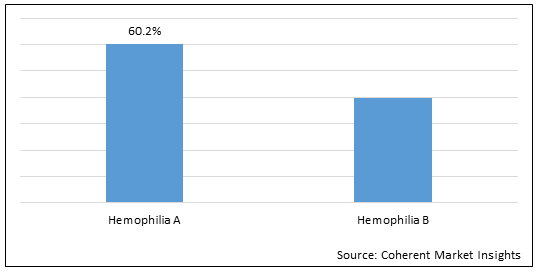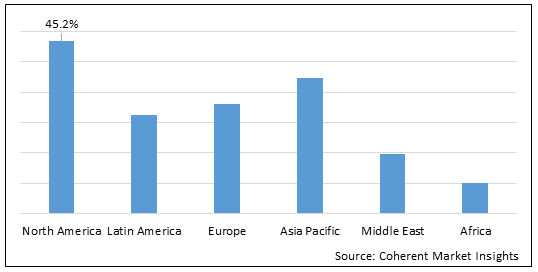Hemophilia is a genetic disorder in which patient’s blood do not clot normally due to lack of blood-clotting proteins known as coagulating factors. Conventional treatment options include timely replacement of the specific clotting factor. Major pharmacy and biotech companies are conducting research and development to develop gene therapy for hemophilia due to various shortcomings with conventional therapy. Increasing number of hemophilic patients that require treatment and strong product pipeline are expected to drive growth of the hemophilia gene therapy market.
The global hemophilia gene therapy market is estimated to be valued at US$ 330.9 million in 2022 and is expected to exhibit a CAGR of 43.6%% during the forecast period (2022-2030).
Figure 1. Global Hemophilia Gene Therapy Market Share (%), by Hemophilia Type, 2022

To learn more about this report, Download Free Sample
Hemophilia Gene Therapy Market Report Coverage
| Report Coverage | Details | ||
|---|---|---|---|
| Base Year: | 2021 | Market Size in 2022: | US$ 330.9 Mn |
| Historical Data for: | 2017 to 2020 | Forecast Period: | 2022 to 2030 |
| Forecast Period 2022 to 2030 CAGR: | 43.6% | 2030 Value Projection: | US$ 2,197.9 Mn |
| Geographies covered: |
|
||
| Segments covered: |
|
||
| Companies covered: |
BioMarin Pharmaceuticals, Inc., Spark Therapeutics, Pfizer, Inc., UniQure NV, Ultragenyx Pharmaceutical, Shire, Sangamo Therapeutics Inc., and Freeline Therapeutics. |
||
| Growth Drivers: |
|
||
| Restraints & Challenges: |
|
||
Uncover macros and micros vetted on 75+ parameters: Get instant access to report
Increasing hemophilia patient base worldwide especially in developed countries is expected to drive growth of the hemophilia gene therapy market:
High prevalence of hemophilia is increasing the demand for sustainable treatment of the disease, which is projected to drive the market growth over the forecast period. According to the National Hemophilia Foundation factsheet 2018, hemophilia affected over 400,000 individuals worldwide. Moreover, according to same source, an estimated 75% of patients suffering from hemophilia have no access to treatment or receive inadequate treatment. According to the Centers for Disease Control and Prevention (CDC) report, Hemophilia A occurs in 1 out of 5,000 live male births. It is around four times more common than Hemophilia B. Few effective treatments available for hemophilia require lifetime infusion of expensive drugs manufactured through recombinant biotechnology or from human plasma.
Furthermore, in September 2019, according to the American Journal of Managed Care, the meta-analysis showed that more than 1,125,000 men around the world have the inherited bleeding disorder; 418,000 of those have a severe version of the mostly undiagnosed disease. Previously, only 400,000 people globally were estimated to have hemophilia.
The study found that, per 100,000 males, there are:
Per 100,000 males, the prevalence at birth is:
For those born with hemophilia, the chances of living a life of normal duration and quality will be reduced by 64% in upper-middle income countries, 77% in middle income, and up to 93% in low income countries. In 2020, the World Federation of Hemophilia (WFH) identified 165,379 people with haemophilia A and 33,076 people with haemophilia B worldwide.
Moreover, according to Center for Disease Control and Prevention, Hemophilia A affects 1 in 5,000 male births and about 400 babies are born with hemophilia A each year.
Figure 2. Global Hemophilia Gene Therapy Market Share (%), by Region, 2022

To learn more about this report, Download Free Sample
Strong gene-based product pipeline for hemophilia treatment is expected to drive the hemophilia gene therapy market growth
Gene therapy for hemophilia has strong product pipeline, which is expected to enter the market in the near future. This is expected to drive the market growth, as it would result in availability of new treatment options for management of hemophilia. In Januarys 2019, over 15 investigational gene therapy are under the clinical development stage. In December 2018, Spark Therapeutics announced updated preliminary data for the ongoing phase 1/2 clinical trial of investigational SPK-8011 in hemophilia A.
Current therapies for treating hemophilia are only symptomatic management of the disease by administering clotting factors XIII or IX. Furthermore, there are serious adverse effects associated with plasma derived products, and limited access to treatment. Gene therapy may address these issues to certain level. BioMarin Pharmaceutical’s gene therapy product Valoctocogene roxaparvovec for hemophilia A was in phase III of clinical development in 2019.
Furthermore, in January 2021, the League of Clinical Research, Russia carried out Interventional study for Efmoroctocog Alfa Injection [Eloctate] to treat haemophilia A. The study is currently in Phase 4 and the study is estimated to be completed on November 15, 2022.
Global Hemophilia Gene Therapy Market – Impact of Coronavirus (COVID-19) Pandemic
Since the COVID-19 virus outbreak in December 2019, the disease has spread to over 100 countries across the globe and the World Health Organization had declared it a public health emergency on January 30, 2020.
COVID-19 can affect the economy in three main ways: by directly affecting production and demand of drugs, medical devices, nutrition supplements, etc. by creating disruptions in distribution channels, and through its financial impact on firms and financial markets. Due to nationwide lockdowns, several countries, such as China, India, Saudi Arabia, U.A.E., Egypt, and others, are facing problems with regards to the transportation of drugs from one place to another.
However, the COVID-19 pandemic had a negative impact on the global hemophilia gene therapy market, owing to the decrease in the research and development activities due to the COVID -19 pandemic. For instance, in July 2020, according to the National Center for Biotechnology Information, the research and development activities for the development of vaccine used in the prevention of coronavirus was on priority at the time of COVID-19 pandemic. As part of the WHO’s response, the R&D Blueprint was activated to accelerate diagnostics, vaccines and therapeutics for this novel coronavirus. The Blueprint aims to improve coordination between scientists and global health professionals, accelerate the research and development process, and develop new norms and standards to learn from and improve upon the global response. On 30 January 2020, following the recommendations of the Emergency Committee, the WHO Director-General declared that the outbreak constitutes a Public Health Emergency of International Concern (PHEIC). World scientists on COVID-19 then met at the World Health Organization’s Geneva headquarters on 11–12 February 2020 to assess the current level of knowledge about the new virus, agree on critical research questions that need to be answered urgently, and to find ways to work together to accelerate and fund priority research to curtail this outbreak and prepare for those in the future. Hence, it slowed down the research and development activities for the drugs used in the treatment of hemophilia.
Global Hemophilia Gene Therapy Market: Key Developments
In July 2022, Sanofi, pharmaceutical and healthcare company, and Swedish Orphan Biovitrum, biopharmaceutical company collaborate on the development and commercialization of efanesoctocog alfa. The U.S. Food and Drug Administration (FDA) granted Breakthrough Therapy designation to efanesoctocog alfa (BIVV001) for the treatment of people with hemophilia A, a rare and life-threatening bleeding disorder, based on data from the pivotal XTEND-1 Phase 3 study. Efanesoctocog alfa is the first factor VIII therapy to be awarded Breakthrough Therapy designation by the FDA. Efanesoctocog alfa is a novel and investigational factor VIII therapy designed to provide normal to near-normal factor activity levels for the majority of the week in a once-weekly prophylactic treatment regimen. Breakthrough Therapy designation is designed to expedite the development and review of drugs in the U.S. that target serious or life-threatening conditions. Drugs qualifying for this designation must show preliminary clinical evidence that the drug may demonstrate a substantial improvement on clinically significant endpoints over available therapies.
Global Hemophilia Gene Therapy Market: Restraint
The major factors that hinder growth of the global hemophilia gene therapy market include serious adverse effects associated with plasma derived products, and limited access to hemophilia treatment. For instance, in September 2019, according to the National Center for Biotechnology Information, a major complication of treatment with coagulation factor concentrates in hemophilia is the development of alloantibodies directed against factor VIII or IX. A common long-term complication of hemophilia is permanent damage to the joints (hemarthropathy) caused by repeated bleeding episodes.
Key Players
Major players operating in the global hemophilia gene therapy market include BioMarin Pharmaceuticals, Inc., Spark Therapeutics, Pfizer, Inc., UniQure NV, Ultragenyx Pharmaceutical, Shire PLC Sangamo Therapeutics, Inc., and Freeline Therapeutics.
Share
Share
Missing comfort of reading report in your local language? Find your preferred language :
Transform your Strategy with Exclusive Trending Reports :
Frequently Asked Questions
Select a License Type
Joining thousands of companies around the world committed to making the Excellent Business Solutions.
View All Our Clients